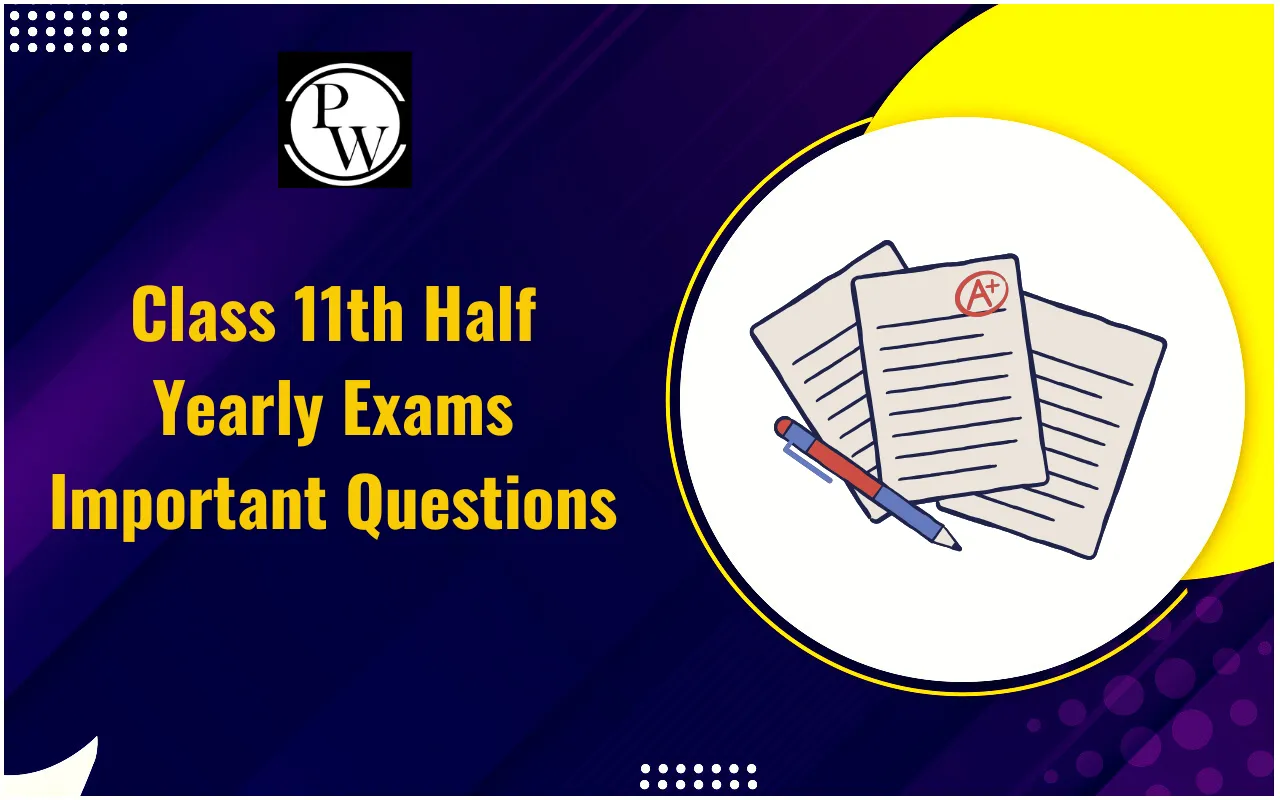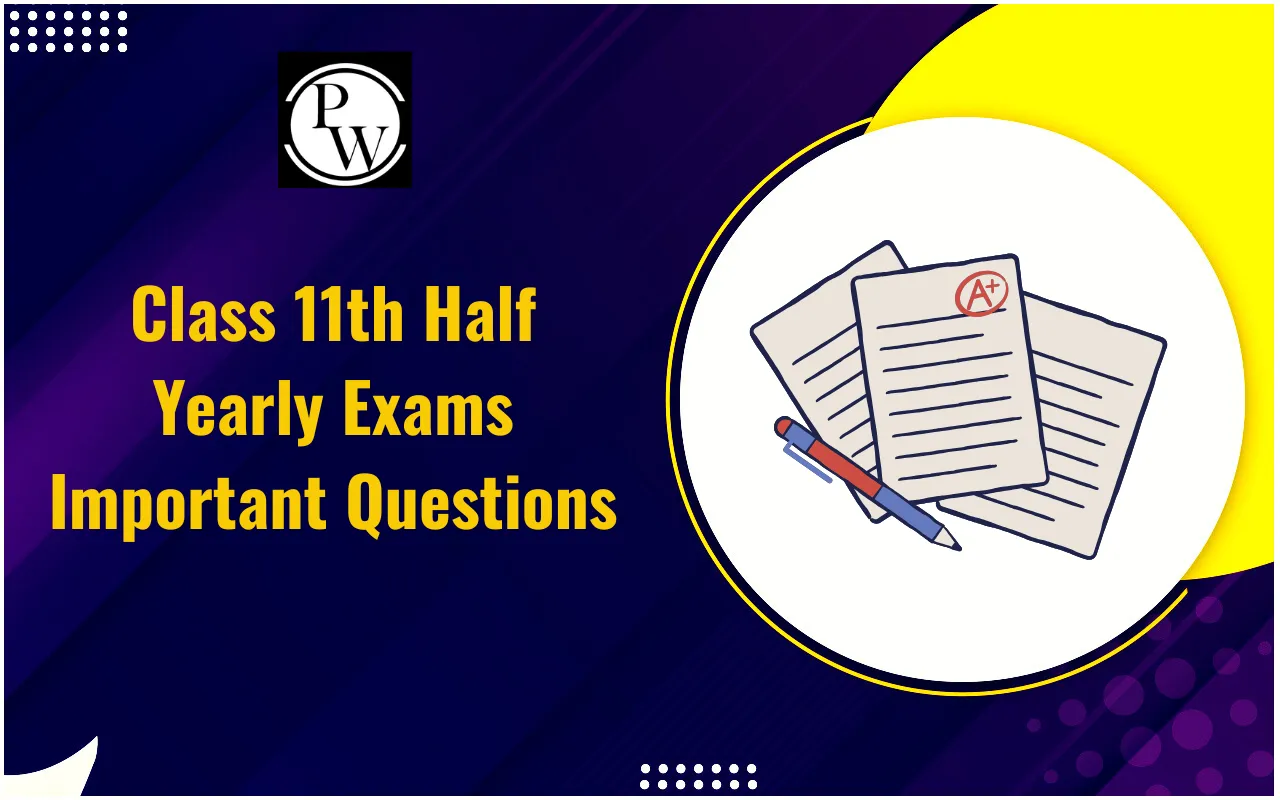

Class 11 Half-Yearly Exam Important Questions: Class 11 half-yearly exams are very important for commerce stream students. These exams test how well students have understood the first half of the syllabus. Knowing the Class 11 half yearly exam important questions Commerce stream helps in preparing smartly.
It also saves time and gives confidence before exams. Below, we will cover Class 11 Economics important questions half yearly, Class 11 Accountancy important questions half yearly, and Class 11 Business Studies important questions half yearly.
Class 11 Half-Yearly Exam Important Questions Commerce Stream
The Class 11 commerce half yearly exams assess students understanding of the first half of the syllabus. In Economics, focus is on microeconomics, consumer behavior, demand, production, and statistics. Accountancy emphasizes basic concepts, journal entries, trial balance, GST, and depreciation.
Business Studies covers business types, risks, services, emerging trends, and ethics. These exams not only gauge learning but also prepare students for the final exams by reinforcing key topics and concepts.
More Details: https://www.youtube.com/live/s-FjG6E9Ovo
Class 11 Economics Important Questions Half Yearly
Economics is a fascinating subject. It helps us understand how the world works. For the Class 11 half-yearly exam important questions Commerce stream, students need to know both Microeconomics and Statistics. Focus on the core concepts.
The questions often test the understanding of these core ideas. Below, we’ve some Class 11 Economics important questions half yearly:
|
Class 11 Economics Important Questions Half Yearly |
|
|
Topic |
Important Questions |
|
Introduction to Microeconomics |
1. What are the central problems of an economy? Explain with examples. 2. Draw and explain the Production Possibility Curve (PPC). What are its properties? 3. Explain the concept of opportunity cost using a PPC diagram. 4. What is the difference between microeconomics and macroeconomics? |
|
Consumer Equilibrium |
1. Explain the Law of Diminishing Marginal Utility. Use a table and a diagram. 2. What are the conditions for consumer equilibrium in the case of a single commodity? 3. Explain consumer equilibrium using the indifference curve approach. 4. What are the properties of indifference curves? |
|
Demand and Elasticity |
1. Define demand and the Law of Demand. List the factors that affect demand. 2. Explain the different types of price elasticity of demand. 3. Solve numerical problems on the percentage method of elasticity of demand. 4. What is the difference between a change in demand and a change in quantity demanded? |
|
Production and Cost |
1. Explain the short-run production function, specifically the Law of Variable Proportions. 2. Define total product (TP), marginal product (MP), and average product (AP). Show their relationship using a diagram. 3. Differentiate between fixed costs and variable costs. |
|
Statistics for Economics |
1. What are the functions and limitations of statistics? 2. Explain the different types of data: primary vs. secondary data. 3. What is a census method? What is a sample method? Explain their pros and cons. 4. Draw and explain a Histogram and a Pie Chart. What are they used for? |
Class 11 Accountancy Important Questions Half Yearly
Accountancy is all about numbers and rules. To do well, students need to be clear about the basics. This includes a clear understanding of concepts and practicing numerical problems. Below, we’ve mentioned some key questions for the Class 11 Accountancy important questions half yearly:
|
Class 11 Accountancy Important Questions Half Yearly |
|
|
Topic |
Important Questions |
|
Basic Accounting Concepts |
1. Define capital, drawings, assets, and liabilities with examples. 2. What is the business entity concept? How does it affect accounting? 3. Explain the difference between cash basis and accrual basis of accounting. 4. Differentiate between revenue and capital expenditure. |
|
Rules of Debit and Credit |
1. Explain the Golden Rules of Accounting for personal, real, and nominal accounts. 2. Pass journal entries for various transactions, including those involving GST. 3. How is a ledger prepared from a journal? Explain the process of posting. 4. What is a trial balance? What are its objectives? |
|
Subsidiary Books and BRS |
1. What are subsidiary books? Explain the purpose of a Cash Book and a Purchase Book. 2. Prepare a single-column and a double-column cash book from given transactions. 3. What is a Bank Reconciliation Statement (BRS)? Why is it prepared? 4. Prepare a Bank Reconciliation Statement from a given cash book and passbook balances. |
|
GST and its Accounting |
1. Explain the concept of GST (Goods and Services Tax). What are Input and Output GST? 2. Differentiate between Intra-state and Inter-state transactions with GST. 3. What is the Reverse Charge Mechanism under GST? |
|
Depreciation |
1. What is depreciation? Explain its causes. 2. Explain the Straight Line Method (SLM) of calculating depreciation with an example. 3. Differentiate between the Straight Line Method and the Written Down Value Method. |
Class 11 Business Studies Questions Half Yearly
Business Studies is about understanding how businesses work. It covers everything from setting up a business to modern business trends. This subject requires students to be clear with the concepts and able to express them well. Below, we’ve mentioned some Class 11 Business Studies important questions half yearly:
|
Class 11 Business Studies Questions Half Yearly |
|
|
Topic |
Important Questions |
|
Nature and Purpose of Business |
1. Define business. What are its characteristics? 2. Differentiate between business, profession, and employment. 3. What is the role of profit in a business? 4. Explain the different types of business risks. |
|
Forms of Business Organizations |
1. What is a sole proprietorship? Explain its merits and demerits. 2. Define a partnership firm. What are its features and types? 3. Explain the features of a Joint Hindu Family Business. 4. What is a Joint Stock Company? What are its key features? |
|
Public, Private and Global Enterprises |
1. Differentiate between the public sector and the private sector. 2. What is a Joint Venture? Explain its benefits. 3. What is a Multinational Corporation (MNC)? Discuss its features. |
|
Business Services |
1. What are the different types of banking services? Explain them. 2. Explain the principles of insurance. 3. What is a warehouse? Explain the different types of warehouses. |
|
Emerging Modes of Business |
1. What is e-business? What are its scope and benefits? 2. Differentiate between e-business and traditional business. 3. Discuss the limitations of e-business. |
|
Social Responsibility of Business and Business Ethics |
1. What is social responsibility? Explain the arguments for it. 2. Discuss the social responsibilities of a business towards different groups like consumers, employees, and the government. 3. Define business ethics. Why are they important? |
Class 11 Half Yearly Exams Preparation Tips
Preparing for exams can feel overwhelming. But with a good plan, students can do great! These tips will help them manage their study time and ace the Class 11 half yearly exam important questions Commerce stream.
-
Make a Study Plan: Create a timetable. This helps students cover all subjects and topics. Give more time to topics students find difficult.
-
Practice is Key: For Accountancy, practice is a must. Solve as many numerical problems as students can. This is the only way to master it.
-
Write Point-wise Answers: Examiners like answers that are easy to read. Write the answers in points, not long paragraphs. Use headings and subheadings.
-
Draw Diagrams: For Economics, diagrams are very important. Practice drawing PPC, demand curves, and indifference curves. A well-labeled diagram can get the full marks.
-
Review and Revise: Don't just study new topics. Go back and revise what students have already studied. Revision helps students remember concepts better.
-
Solve Sample Papers: Find some CBSE Class 11 half yearly Commerce papers. Solving them will give students an idea of the exam pattern. It also helps students manage their time.
